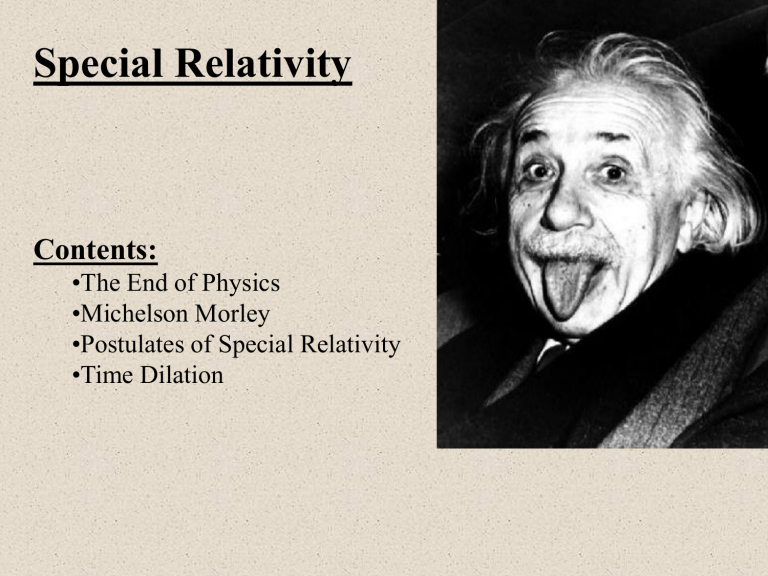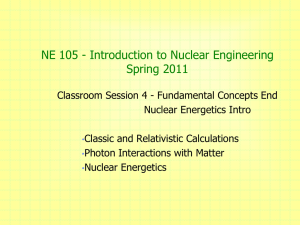01-01SpecialRelativity-Time-Length-Mass

Special Relativity
Contents:
•The End of Physics
•Michelson Morley
•Postulates of Special Relativity
•Time Dilation
The End Of Physics
1900 +/- 5
The End of physics
Black Body Radiation -> Quantum mechanics
Velocity of light With Respect to ether
Maxwell’s Equations… c
1
o
o
But what does light move through?
Ether
Michelson Morley
Path parallel to ether should take a bit longer
Tried it in January
Tried it in June…
The Earth is at rest in ether
Or the path parallel to the ether shrinks
Or, there is no ether
So what does light travel through ?
Einstein’s Gedanken
If we caught up to an EM wave what would we see:
B and E fields with nothing to create them
This is impossible
Therefore we cannot catch up to light waves…
Postulates of Special Relativity
First Postulate:
•The laws of physics are the same in all inertial frames of reference
•There is no experiment you can do to ascertain whether you are moving.
•(i.e. all motion is relative)
Second Postulate:
•The speed of light is the same no matter what speed the source or observer is going
•(i.e the speed of light is a law of physics)
(examples of this with cars/observers/galilean vs relativistic transforms)
The speed of the photons was independent of the speed of the pion
Time Dilation
How the clock works
What proper time is
Time Dilation
Earth observer sees light traveling at speed of light
Time is longer (i.e the clock runs slower)
Derive
Moving clocks run slower
Examples: (time elapsed, velocity, factor of c)
Lorentz factor:
Factor Vs V
8
7
6
5
4
3
2
1
0
0 0.5
Speed in c
1 1.5
You can safely ignore relativistic effects to about .2 c
Example 1: If you drive by the school at 40.0 m/s, how long do we see your watch take to register
10.0 seconds? What about 40,000. m/s? .200 c?
.500 c?
?, ?, 10.2 s, 11.5 s
Example 2: If we see your watch take 12 seconds to register 10. seconds, how fast are you going?
(Show solution for c)
.55c
Length Contraction
l o l
Moving objects shrink in the direction of motion
L
L o
1
v
2 c
2
This reconciles the frames of reference
Mass Dilation
Electron at rest m o
= 0.511 MeV
Electron with 1.0 MeV Ke: m = 1.00 MeV + 0.511 MeV
=1.511 MeV e e
Moving objects gain mass m
m o
1
v
2 c
2
(The gained mass is energy mass as in E = mc 2 )
Example 3: A car that is 5.0 m long is going .60 c past us. How long is the car in our frame of reference?
4.0 m
Example 4: What is the speed of an electron if it has a mass of 0.634 MeV. (Its rest mass is 0.511
MeV)
(What is its kinetic energy? through what potential was it accelerated?)
0.592 c
Whiteboards:
Time Dilation, Length Contraction, Mass Dilation
Moe and Joe have clocks that tick every 10.00 seconds. Joe is flying by at .85 c. What time does
Moe see Joe’s clock take to tick? (trick with c)
19 s
Two stopwatches, one sitting still, one moving in a very large circle. The clock at rest ticks every
.800 s, the moving one ticks every 1.200 s. What speed is the moving watch going?
Show the general solution
.75 c or 2.24 x 10 8 m/s
Moe and Joe both have identical watches. Joe is moving with respect to Moe at .85c. If 15 s elapse on Moe’s clock, how much time has elapsed on Joe’s clock?
7.9 s
answer
Muons have a mean life of 2.2 x 10 -6 s at rest.
What speed are they traveling if they they have an average lifetime of 2.6 x 10 -6 s?
How far would they travel before decaying on the average?
answer
.53c, 1.6 x 10 8 m/s, 415 m
An electron has a rest mass of 0.511 MeV, and a moving mass of 1.511 MeV. What is its speed ?
answer
0.941 c
What speed does a 45 foot long bus need to go to fit exactly into a tunnel that is 40. feet long?
answer
0.46 c
Paradoxes
Planet X
Joe stays on earth
Moe goes to planet x that is 30 Ly away at .99 c
Comes back
How old Moe is/Joe is
Does this violate Special relativity?
Inertial means no acceleration
What they see
Paradoxes
Planet X
Planet X
It’s all relative
Moe sees our clocks slow down too
Postulates only apply to inertial frames of reference







